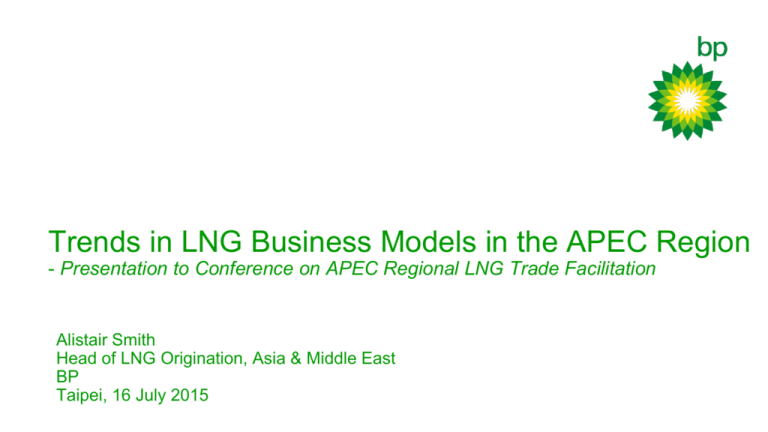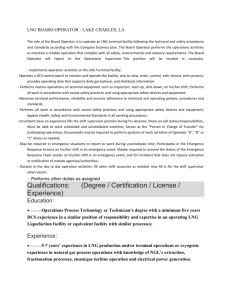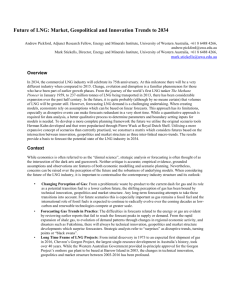
Trends in LNG Business Models in the APEC Region
- Presentation to Conference on APEC Regional LNG Trade Facilitation
Alistair Smith
Head of LNG Origination, Asia & Middle East
BP
Taipei, 16 July 2015
Disclaimer
This presentation and its contents are provided for informational purposes only. This information is not advice on or a recommendation of any of the matters described herein or any
related commercial transactions. BP makes no representations or warranties, express or implied, regarding the accuracy, adequacy, reasonableness or completeness of the
information, assumptions or analysis contained herein or in any supplemental materials, and BP accepts no liability in connection therewith. BP deals and trades in energy related
products and may have positions consistent with or different from those implied or suggested by this presentation.
To the extent the presentation contains statements that are not historical facts, including statements about the BP's beliefs or expectations, these forward-looking statements are
made based on the presenter’s understanding of BP’s current assessment. These statements are based on the presenter’s knowledge of plans, estimates and projections and you
should not place undue reliance on them. These statements are not guarantees of future performance and involve certain risks and uncertainties, which are difficult to predict.
Therefore, actual future results and trends may differ materially from what is forecast, suggested or implied in any forward-looking statements due to a variety of factors. BP
disclaims any intention or obligation to publicly or privately update or revise any forward-looking statements, whether as a result of new information, future events, or otherwise.
The recipient’s use of the information contained in this presentation is at their own risk, and BP expressly disclaims (to the extent permitted by applicable law) any liability for any
errors, omissions or representations and for the use or interpretation thereof by others. The information contained in this document shall not be modified, reproduced, distributed or
otherwise disseminated in whole or in part in any manner by any party without prior written permission from BP. The information within this presentation creates no legal rights for
the recipient or obligations for BP, and all rights, including copyright, confidentiality and ownership rights, are reserved.
Today’s Presentation
•
Introduction
•
Development of LNG trade in and with Asia
•
Key Asian supply and demand patterns in past 10 years
•
Asia’s increased linkage to Atlantic Basin
•
Growth of spot and mid-term contracts
•
Portfolio supply options
•
Asian LNG outlook
•
Summary of developments in business models and implications for Asia
Long-term contracts enabled modern LNG industry:
LNG trade flows in 1970
LNG export 5 Mtpa (0.65 bcf/d)
LNG import 10 Mtpa (1.3 bcf/d)
Source: BP Internal
SE Asia to Japan and Algeria to Europe trades
dominant by mid 1980s
LNG export 5 Mtpa
LNG import 10 Mtpa
Source: BP Statistical Review of World Energy
Little change in the nature of global LNG trade by mid
1990s but still scaling up
LNG export 5 Mtpa
LNG import 10 Mtpa
Source: BP Statistical Review of World Energy
By 2005, broader Atlantic Basin market evolving and
Middle East suppliers beginning to play balancing role
LNG export 5 Mtpa
LNG import 10 Mtpa
Source: BP Statistical Review of World Energy
LNG has now evolved into a global business:
LNG trade flows in 2014
LNG export 5 Mtpa
LNG import 10 Mtpa
Source: BP Statistical Review of World Energy
Impact of Qatari and other expansion in last ten years
60
50
40
30
20
10
0
-10
-20
Qatar
Australia
Russia
Nigeria
Yemen
Peru
Malaysia
Norway
Trinidad
Eq. Guinea
PNG
Net other
Egypt
Algeria
Indonesia
Mtpa
Change in LNG exports 2005-14
•
Qatar becomes the dominant supplier,
adding more than half of 100 mtpa net
supply increase and cementing its strategic
position straddling the Atlantic and Pacific
•
Multiple new supply sources emerge:
Russia, Yemen, Peru, Norway, Equatorial
Guinea, Angola and Papua New Guinea
•
New projects in Australia: Darwin, Pluto
•
Exports decline in Egypt, Algeria and
Indonesia as upstream production fails to
keep pace with rapid growth in domestic
demand, helping to tighten the market
•
LNG trade becomes much more flexible as a
more liquid market emerges
Source: BP Statistical Review of World Energy
US/Canada
Other Europe
Middle East
S.E. Asia
Mexico
UK
India
LatAm
China
60
50
40
30
20
10
0
-10
-20
Change in LNG imports 2005-14
JKT
Mtpa
These ten years have also seen Asia able to call on
flexible Atlantic LNG supply
•
Japan/Korea/Taiwan (JKT) demand continues
to grow strongly
•
Major new demand centres emerge in China,
India, Latin America, the United Kingdom,
Mexico, South East Asia and the Middle East
•
Emergence of smaller LNG markets is
facilitated by maturing Floating Storage &
Regasification (FRSU) technology
•
Market tightens considerably following March
2011 Fukushima nuclear accident in Japan
•
Emergence of shale gas in US releases LNG
supply and promotes LNG export
•
Asian market tightness exerts strong pull on
Atlantic Basin supply, incentivising diversions
and reloads from the US and Europe
Source: BP Statistical Review of World Energy
Wide Pacific-Atlantic price arbitrage enabled interbasin trade flows in recent years
20
18
Japan average LNG import price
US$/mmbtu
16
14
US LNG to Asia
12
10
8
6
4
2
US LNG to Europe
UK NBP
US Henry Hub
0
Source: ICE, NYMEX, BP analysis
Spot & short term LNG sales* now account for almost
30% of the global market
70
35%
Mt per annum
60
50
40
30%
Spot & short term
LNG sales (LHS)
25%
Share of global
Market (RHS)
20%
30
15%
20
10%
10
5%
0
0%
2005 2006 2007 2008 2009 2010 2011 2012 2013 2014
* Spot sales and sales under contracts < 4 years in length
Source: GIIGNL
BP’s global LNG portfolio makes it better able to meet
buyers’ growing demand for flexibility
Isle of Grain
Alaska LNG
GATE
Rovigo
Cove Point
Costa Azul
Freeport LNG
Dominican
Republic
Bilbao
Reloads
SEGAS
Trinidad
ADGAS
IGS
3rd party DES
Asia
Japanese
Terminals
Taiwan Terminals
Fujian
Tangguh
Bontang
Angola
Gorgon
Existing Supply Resource
Future Supply resource
Korean
Terminals
Kuwait
Browse
NWS
Argentina
Existing Market Access
Marketing Joint Venture
Trading Hub
LNG
4 x GEM
3 x Trader
1x Time Charter
Source: BP Internal
Outlook for strong future growth of LNG, with Asia’s
share of global trade set to remain above 70%
Source: BP Energy Outlook 2035
© BP plc 2015
Changes in LNG business models in Asia have
occurred alongside these new trade flows
•
Regional markets now highly connected, even with new Asian supply
•
Availability of spot and flexible volumes
•
Long-term contracts taking a smaller share of global trade, though still >70%
•
Long-term contracts are themselves exhibiting new types of flexibility
•
Equity LNG lifting and marketing playing a greater role in Asian trade flows
•
Portfolio sales increasingly used by Buyers
•
Emergence of new players
•
Strong growth expected across established and new Asian LNG markets
•
Buyers looking for greater reliability and flexibility from LNG business models







